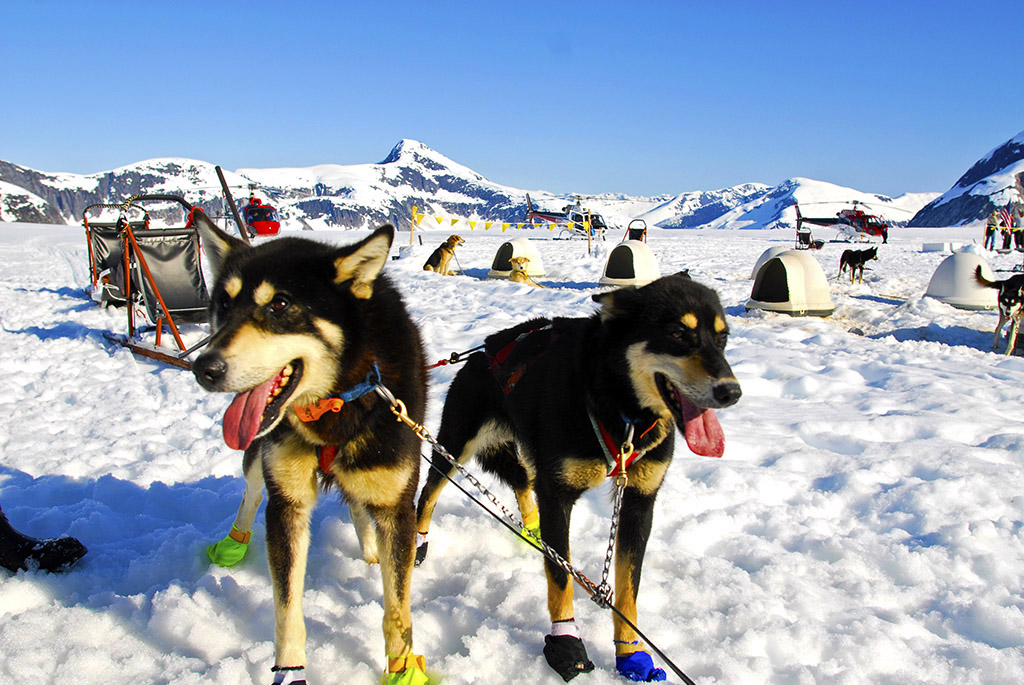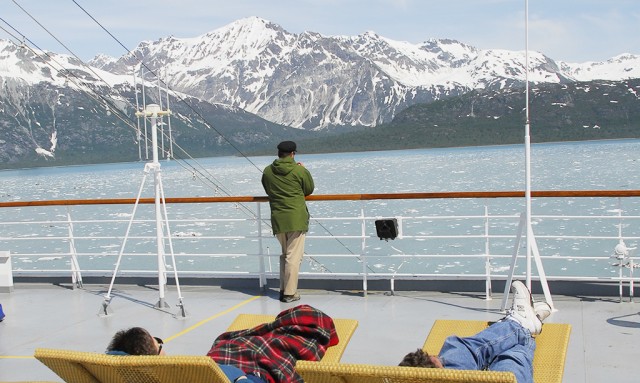
It’s probably easier to get high in Juneau than anywhere in the world.
Holland America’s Volendam docked in Alaska’s capital right next to the entrance of a cable car that in minutes can whisk visitors to a mountain top with a sweeping view of glacial gorges and eagles soaring.
But I had something a lot more adventurous in mind: boarding a helicopter for a panoramic tour of the vast Mendenhall Glacier and then setting down on its snowy summit to learn the art of racing a competitive dog team.
Even though it was hot and dry at sea level, the four passengers in my chopper were fitted out with boots for the chilly–and just a bit mushy– snow atop the glacier.
By chopper it’s easy to swoop low over glaciers that are like giant tongues licking notches in the mountains as they creep ever so slowly to the sea. Over the years, pressure turns snow into inky blue ice that creates a contrast to the fresh white of the surface. You don’t realize the vast scale of this mountain until you see another helicopter coming the other way, as a distant tiny dot against this vast ice field.

We hop off the chopper at a dog camp that has long rows of dozens of kennels that look like mini-igloos. I’m told the summer camp has been run here in the Alaska panhandle since the 1990s because it is actually cooler here than it is further north and the snow is always reliable.
The dogs are friendly and extremely personable, used to having lots of human attention. They’re and a mix of Husky and other muscular breeds that trace their lineage back to the days of the gold rush, some with nostalgic names like Dawson and White Fang but just as likely to be called Draco or Gidget
The Juneau camp is a training site for teams that compete in the gruelling Iditarod race and all the guides have competed in races including the 1,000-mile Yukon Quest.
Starting out, Mike, my racing guide, has me sit in the sled while he demonstrates getting up and running. The team of eight dogs is linked with a nylon harness and it’s easy to get up to a fast clip on the long sled with its big ski-like runners.
Then, we stop and it’s my turn.
When I said “mush” I had a dozen eyes staring at me. That’s not right, the team seemed to say as they turned their heads and barked in unison. I’m the musher, Mike explained. If you want to get this sled going, the word is “hike.”
The musher’s job is to stand on the runners at the rear of the sled holding the reins and signalling with commands where the sled should go. There’s a brake as well, a pedal with spikes in it that dig into the ice to slow the sled, telling the team that it’s time to shift direction.
To do this in competition can be more complex than driving a grand prix race, but the basics are that “haw” means go left and “gee” means head right. The lead dog is the most experienced in the team and whatever way the leader goes, the rest will follow.
As we rode on for about half an hour, the scene all around was so remote and gorgeous that I almost forgot that we still had another helicopter ride home, this time right over the mountain to another spectacular ice field for another 20 minutes of sightseeing before touching down.
At close to $500 a person, the glacier dog camp excursion one of the most expensive day trips you can do from a ship in Alaska, but it’s by far the most memorable.



http://youtu.be/HJamvzMmnBs This was our dog sled adventure…..I think it’s the same one from this article.